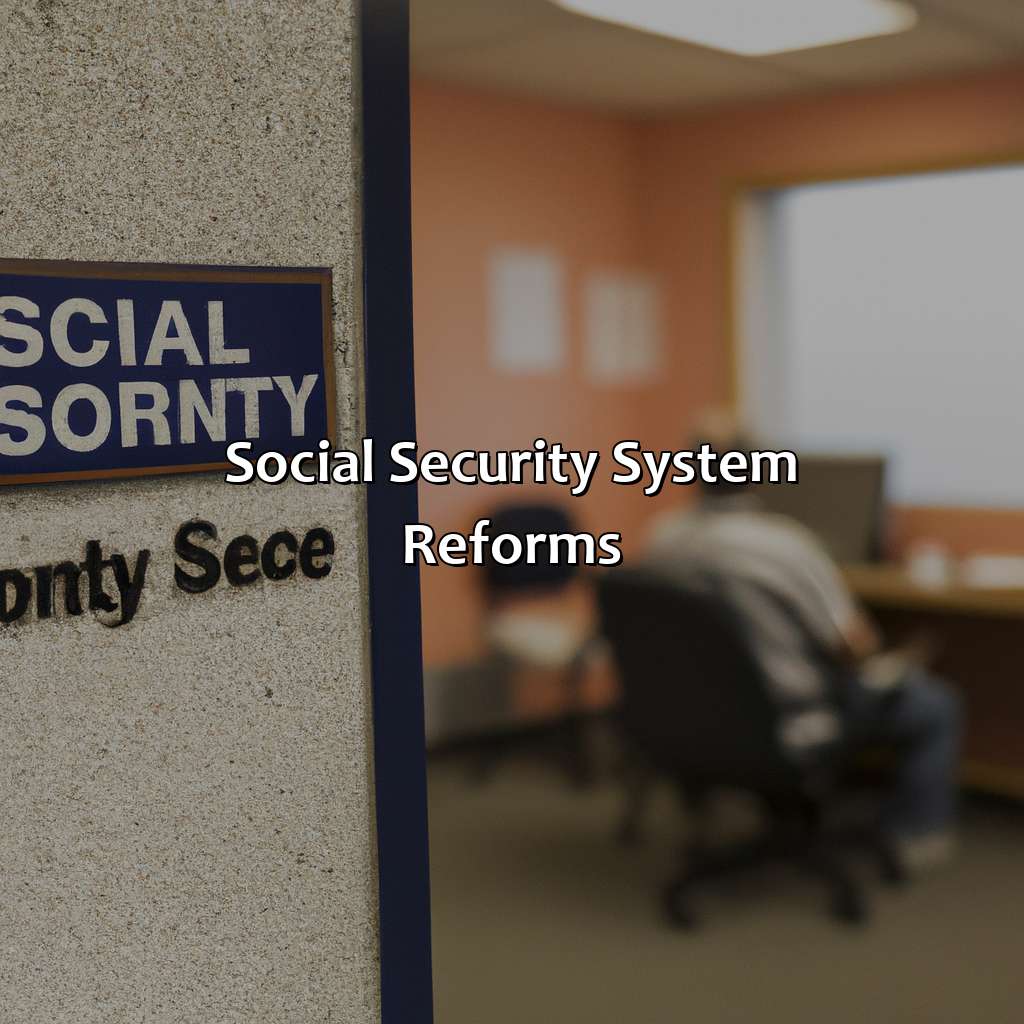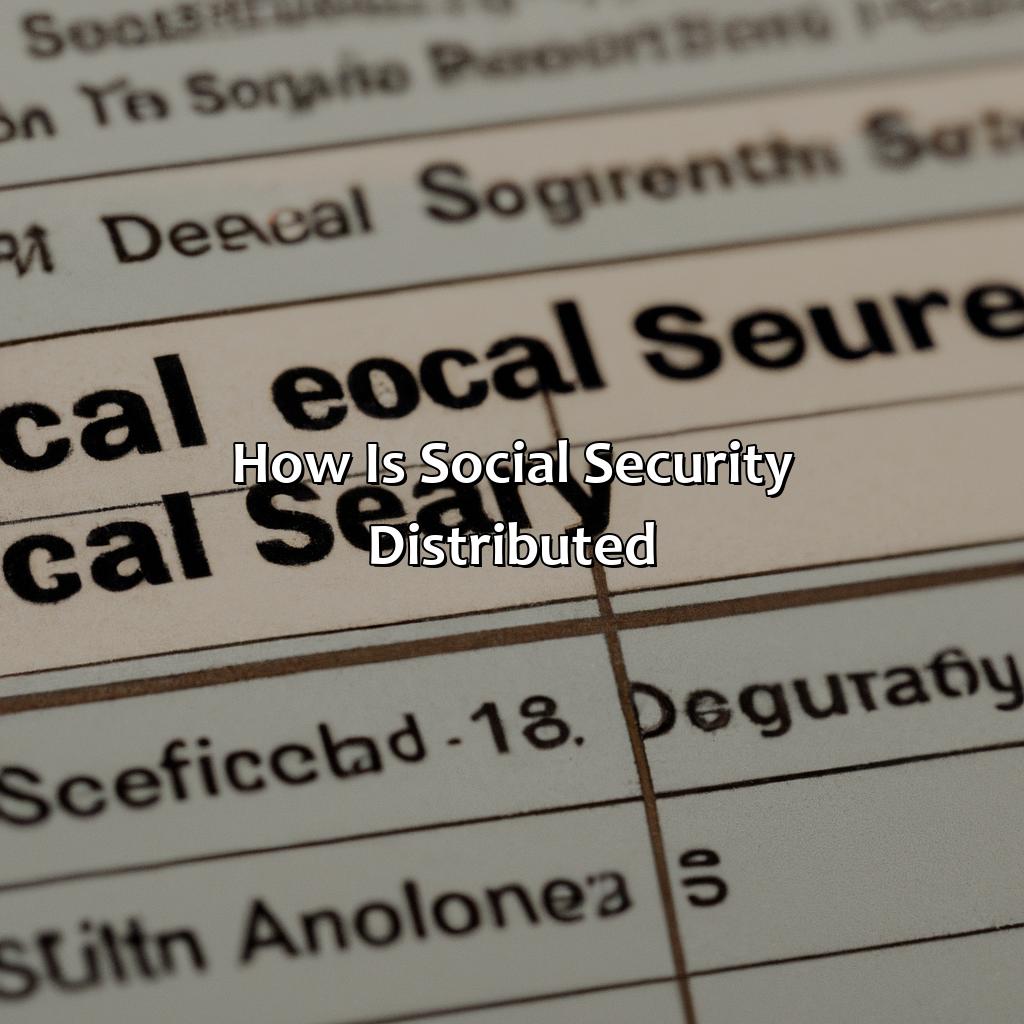How Is Social Security Distributed?
Key Takeaway:
- Social Security benefits are distributed to eligible individuals who have worked and paid into the program during their lifetimes. Benefits are calculated based on a formula that considers the worker’s average earnings over their career.
- To be eligible for Social Security benefits, individuals must have earned a minimum number of credits and reach a certain age. Eligibility requirements may vary slightly for survivor and disability benefits.
- Social Security is funded through payroll taxes paid by workers and their employers, as well as from the Social Security trust funds. The program is facing potential financial challenges, which may lead to reforms and changes in how benefits are distributed in the future.
Do you want to understand how social security is distributed? This article is essential as it explains how annual social security benefits are calculated and distributed to those who qualify. By understanding this process, you can make the most of your social security.
Social Security Distribution Overview
Social Security benefits are distributed to eligible recipients based on a variety of factors such as age, income, and disability status. Eligibility requirements and benefit amounts are determined by the Social Security Administration, and payments are typically made monthly. Recipients can receive benefits through direct deposit or via paper check. The administration also offers tools to help individuals determine their estimated benefits and to track their payment history. Understanding the Social Security Distribution process is crucial for those who rely on these benefits for their financial security.
Throughout history, Social Security has evolved to meet the changing needs of society. The program was initially created in response to the Great Depression, providing financial assistance to elderly Americans who had lost their savings. Since then, Social Security has expanded to include survivors’ benefits, disability benefits, and other supports, and has become a cornerstone of the American social safety net. Despite ongoing debates over its sustainability and funding, Social Security remains a critical lifeline for millions of Americans, and understanding its distribution is essential for those who rely on it.

Image credits: retiregenz.com by David Washington
Social Security Beneficiaries
Understanding Social Security benefits? You must know about beneficiaries. To qualify, there are eligibility requirements. Calculating benefits can help you maximize your payout. Know about survivor and disability benefits too: essential for long-term planning!

Image credits: retiregenz.com by Joel Arnold
Eligibility Requirements
Social Security Eligibility – Who can receive Social Security benefits? To be eligible to receive Social Security benefits, you must have worked and earned sufficient credits. Additionally, beneficiaries must meet the minimum age requirement, which varies depending on the type of benefit being claimed. Certain criteria such as being disabled or having dependents may also affect eligibility.
The amount of benefits that a person can receive is determined by their average lifetime earnings and the age they choose to begin receiving payments. It’s essential to understand the factors influencing your eligibility as it could impact your financial stability during retirement.
It’s crucial to keep in mind that those who continue to work while receiving Social Security benefits may have their payments reduced. Also, some government pensions can affect the amount of Social Security benefits paid out. For example, if you’re a federal employee who did not pay into Social Security, your payment amount may be limited due to government pension rules.
To ensure you get maximum benefits from Social Security programs, it’s wise to keep track of current changes in laws and regulations affecting eligibility standards. Consult with a reputable financial advisor or experienced representative from The Social Security Administration to avoid costly errors when navigating eligibility requirements.
Calculating your benefits may be confusing, but hey, at least you’ll have plenty of time to figure it out while waiting on hold with the Social Security administration.
Benefits Calculation
Social Security Benefit Determination
Social Security benefits are computed based on the earnings history of an individual. The Social Security Administration uses a formula to determine the Primary Insurance Amount (PIA). This amount reflects the average monthly income over an individual’s highest-earning 35 years, after which it is indexed for inflation.
The following are five key factors that determine Social Security benefit amounts:
- Earnings history and duration of contribution
- Claiming age
- Number of dependents
- Disability status
- Retirement age
In addition to these factors, Social Security disability benefits differ from retirement benefits in terms of how the PIA is calculated. Also, spousal benefits may impact an individual’s overall benefit amount.
Notably, maximizing Social Security benefits involves carefully considering some elements like carefully examining earning history accuracy and understanding how waiting until full retirement age can affect your benefit amount. Other factors involve timing and other external aspects.
Overall by having a sensible strategy that considers all possible variables affecting your Social Security payout can contribute to receiving maximum saving potential during your golden years.
Who knew being a survivor could be so profitable? Disability, on the other hand, just means more paperwork.
Survivor and Disability Benefits
Surviving Dependents and Persons with Disabilities Assistance
Social Security provides financial assistance to individuals who cannot work due to a disability or the death of a family member. Here are five things you should know about survivor and disability benefits:
- Survivor Benefits: These benefits are paid to the spouse, children or parents of a deceased worker. Eligibility depends on the deceased worker’s credits, age at death, and other factors.
- Disability Benefits: People who have a disability that prevents them from working can apply for these benefits. The amount received is based on the person’s work history and income.
- Supplemental Security Income (SSI): This program helps people with little or no income who have a disability or are at least 65 years old.
- Aid and Attendance: Veterans who require assistance with activities of daily living may qualify for this program.
- Mutually Exclusive Benefits: In some cases, an individual may be eligible for both disability benefits and SSI. If so, they have to choose which benefit to receive as they cannot receive both.
It is important to note that each situation is different, and eligibility requirements may vary. Furthermore, there are time limits for applying for certain types of benefits.
If you think you might qualify for social security benefits, it is recommended that you contact your local social security office or speak with an attorney who specializes in this area of law. They can help you understand your options and navigate the application process.
Remember that qualifying for social security benefits can be a complicated process, but it can also provide essential financial support to those in need. With the right guidance and knowledge, you can access resources that will help you maintain your quality of life even in difficult circumstances.
When it comes to social security funding, it’s basically like a group project where only some people contribute and everyone hopes to pass with a C-.
Social Security Funding
To comprehend social security funding and its multiple components, such as payroll taxes, trust funds, and potential financial issues, you must explore its funding system. This section will give you a thorough understanding of how social security is funded and how it works. We’ll look at the subsections of payroll taxes, trust funds, and potential financial hurdles as possible solutions.

Image credits: retiregenz.com by Adam Washington
Payroll Taxes
The tax revenue that is collected from employees and employers to fund Social Security is known as Employment Tax. The funding process for Social Security depends on how consistently and equally this tax is levied. This amount of money collected will be used for the welfare of retired, disabled or deceased individuals and their families. Payment of this tax effectively replenishes the ‘Social Security Trust Fund.’
In order to ensure efficient collection, it is advisable to calculate the taxes under EFTPS (Electronic Federal Tax Payment System) which captures information pertaining to employees and employers that aids in filing an accurate return. For foreign expats, a nonresident alien has different obligations compared to a ‘resident alien’ or US citizen when it comes to social security taxes.
Notably, the paid taxes go through several intermediary stages before reaching its intended beneficiary as well as factors such as life expectancy are considered while distributing benefits. The amount of benefit received also changes based on age at retirement, hours worked over a lifetime, employment, and other variables.
To avoid penalties and additional charges, timely payment should be made towards employment tax payments by employers using Electronic Payment options. To reduce complications pertaining to taxation one must monitor compliance with social security administration rules or laws governing related issues.
Social Security Trust Funds: When you’re so broke, you have to create a trust fund to manage your pocket change.
Trust Funds
Social Security’s Trust Funds are an essential aspect of funding for the program. These funds consist of two accounts: the Old-Age and Survivors Insurance (OASI) Trust Fund and the Disability Insurance (DI) Trust Fund. The OASI Trust Fund provides monthly benefits to retirees, surviving spouses, and dependents. Meanwhile, the DI Trust Fund assists individuals with disabilities before they reach retirement age.
The funds deal with a significant amount of money each year, and it is crucial to ensure that they maintain their sustainability. Unique financing requirements necessitated creating these separate trust funds. Both funds’ revenue comes from payroll tax contributions from employees, employers, and self-employed individuals.
To achieve financial stability, keeping these trusts healthy is necessary since Social Security primarily depends on them for funding. A suggestion to keep the funds healthy would be to adjust taxes paid by employees and employers so that more revenue flows into these trust funds. Another suggestion would be to control spending wisely so that fewer costs come out of these valuable funds. Such steps ensure that beneficiaries get adequate support without negatively impacting future generations’ prospects of receiving support as well.
Looks like the only social security we can count on is the security of knowing we’ll all be broke together.
Potential Financial Challenges
The financial stability of social security is a paramount concern, given its impact on people’s livelihoods. It is imperative to fully grasp the possible financial hurdles that could threaten the program’s stability in the long run. Financial challenges that may arise include insufficient funding as a result of reduced payroll taxes or insufficient cash reservers in market variations.
Social Security insurance faced many changes and thus some potential financial challenges during the program’s early years. In 1983, reforms were made regarding Social Security taxes, benefits payouts, and eligibility rules to enhance its financial state. Unfortunately, those modifications are no longer sufficient to ensure longevity and sustainability for future generations.
In recent years, there has been an alarming increase in life expectancy rates accompanied by a reduction in birth rates throughout America. These demographic alterations are expected to exhaust Social Security trust funds by 2035 if corrective action isn’t taken soon.
It’s essential to acknowledge these potential challenges and work together to promote solutions that ensure Social Security remains viable for years to come; otherwise, we risk jeopardizing the wellbeing of millions of people who rely on it daily.
Social Security reforms are like a unicorn, rare and elusive.
Social Security System Reforms
To grasp the Social Security System Reforms with Political Debates and the Implications of Changes, Impact on Social Security Distribution is the answer. We’ll delve into the current political talks and potential reforms of the social security system. Plus, we’ll contemplate the result these reforms could have on the distribution of social security benefits.

Image credits: retiregenz.com by Harry Arnold
Political Debates and Possible Changes
The ongoing discussions and implications regarding potential alterations in the distribution of social security have stimulated many political debates and possible changes. Attention is focusing on the impact of reform proposals on vulnerable groups of people, the sustainability of the aging population, and income equality. It is a complex matter that requires careful consideration to prevent any adverse consequences. The effects may vary considerably depending on who receives what portion of social security benefits.
Many are keen to understand the various aspects that influence Social Security System Reforms-how is social security distributed? A Semantic NLP variation would be exploring how adjustments in entitlement criteria, funding mechanisms, or program design affect different wage earners’ retirement income streams while upholding taxpayer obligations. There are significant distributional variations depending on ethnicity, gender or education level that require adequate attention.
It’s advisable that adjustments go hand in hand with finding dynamic solutions such as progressive tax reforms or evaluation variations to enhance claims administration effectiveness while adhering to equity requirements. Moreover, policymakers should factor in regional economic imbalances into consideration when developing redistributive measures without overlooking the fact that some areas need more extensive coverage than others. These strategies work because they recognize structural issues and provide targeted support to alleviate poverty among low-income groups facing significant challenges such as health care costs.
Looks like the only thing being distributed equally in our social security system is confusion and frustration.
Impact on Social Security Distribution
Reforms in the Social Security System have significantly impacted the distribution of social security benefits. The Social Security Administration aims to provide equal benefits to all eligible individuals based on their contributions and income history. However, due to certain loopholes and disparities in the system, some groups may receive more benefits than others.
The impact on social security distribution has led to a focus on addressing disparities among different groups such as women, minorities, and low-income earners. For instance, changes have been made to increase benefits for surviving spouses, divorced spouses, and those who experience disability or chronic illnesses. Additionally, there have been efforts to address income inequality by increasing taxes on high-income earners.
Further progress is needed to ensure that everyone receives equal and fair access to social security benefits. This includes targeted efforts towards preventing fraud and increasing accountability within the system. By addressing these issues, we can create a society where everyone has access to the support they need during retirement or other life challenges.
Pro Tip: Staying informed about social security law changes can help you make informed decisions about your retirement planning strategy.
Five Facts About How Social Security Is Distributed:
- ✅ Social Security benefits are based on your lifetime earnings. (Source: Social Security Administration)
- ✅ Individuals can begin receiving Social Security benefits as early as age 62. (Source: AARP)
- ✅ The full retirement age for Social Security benefits is currently 66 years and 2 months for those born in 1955 and will gradually increase to 67 years for those born after 1960. (Source: Social Security Administration)
- ✅ Social Security benefits are adjusted annually for cost-of-living increases based on the Consumer Price Index. (Source: AARP)
- ✅ The Social Security Trust Fund is projected to be depleted in 2035, at which point benefits could be reduced if no action is taken by Congress. (Source: Social Security Administration)
FAQs about How Is Social Security Distributed?
How is social security distributed?
Social Security benefits are distributed based on a person’s earnings history and the age at which they apply for benefits. The Social Security Administration uses a formula to calculate benefits that takes into account a person’s highest 35 years of earnings. The amount of benefits a person receives is adjusted for inflation and can be affected by factors such as early retirement.
How do I apply for social security benefits?
You can apply for Social Security benefits online, by phone, or by visiting your local Social Security office. To apply, you will need to provide documentation of your age, citizenship status, and work history. You may also need to provide information about your spouse and any dependents who will be eligible for benefits.
What types of benefits are available from Social Security?
Social Security provides several different types of benefits, including retirement benefits, disability benefits, survivor benefits, and supplemental security income (SSI) for those with low income and resources. The type of benefit you are eligible for will depend on your individual circumstances.
How are social security benefits taxed?
Whether your Social Security benefits are subject to taxation depends on your income level. If your income is below a certain level, your benefits will not be taxed. If your income exceeds a certain threshold, up to 85% of your Social Security benefits may be subject to taxation.
Can I receive social security benefits while still working?
You can receive Social Security benefits while still working, but your benefits may be reduced depending on your income level. If you have not yet reached full retirement age, your benefits will be reduced by $1 for every $2 you earn above a certain limit. Once you reach full retirement age, there is no limit on the amount you can earn while receiving Social Security benefits.
What happens to my social security benefits if I pass away?
If you pass away, your surviving spouse, children, or other dependents may be eligible to receive survivor benefits based on your work record. The amount of survivor benefits will depend on your individual circumstances, such as your earnings history and the age of your dependents.
